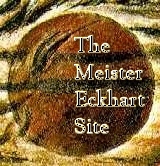|
|
||
 |
Meister Eckhart Home / Works by Meister Eckhart - Quotes / Inspired by Eckhart / Studies / The Papal Condemnation / Mail & Announcements / Links / Books |
AMY HOLLYWOOD
From: M. Rubin, W. Simons (ed.), The Cambridge History of Christianity, v. 4, Christianity in Western Europe, c. 1100 - c. 1500, Cambridge 2009 (Pages 297-307).
Page 2
Deeply dependent on the Neoplatonic ontologies crucial to the process of his conversion, Augustine here describes a movement through the material to the immaterial and, further, from the realm of souls to that of Wisdom.
Yet where the pagan philosopher Plotinus (d. 270) writes of the individual soul's movement into, through and beyond itself into universal Soul, the Mind and the One, Augustine insists on the necessity of divine mediation for this uplifting and return to occur. Just as the mediation of the incarnate Christ is necessary to Augustine's final conversion, here Wisdom is the Word, the God become human through whom salvation becomes possible. (And whereas in Plotinus the creation of all things occurs through the emanation of the One into the Mind, the Mind into Soul, and the Soul into the realm of material creation, for Augustine creation occurs through Christ as Word and Wisdom, who 'gives new life to all things'. )
I start with Augustine because his work sets the agenda for the mysticism of the high and late Middle Ages. If the years from 1100 to 1500 are often seen as the moment of mysticism's 'flowering' in the West, [2] the foundations for this tradition are laid byGreek and Latin Christians writing in late antiquity and the earlyMiddle Ages. For this reason, I will at times make reference to this earlier work, which provides the background against which monks, nuns, members of the new religious movements and eventually the laity lived, practised, and thought about the mystical life.
Thus, although scholars continue to debate whether or not Augustine himself was a mystic, [3] there is no doubt that this passage from the Confessions encapsulates themes crucial to the development of Western Christian mysticism. The episode is marked by four features that will play an important role in subsequent mystical traditions. First, Augustine and Monica strive to transcend not only the material realm, but also their own individual souls. Although primarily grounded in the use of the intellect, love – signified here by the heart – is also crucial to the process of transcendent uplifting. Secondly, inso far as they touch that transcendent Wisdom in which their souls are contained and unified, Augustine and Monica do so only fleetingly. This momentary grasp of the divine Word, thirdly, is explicitly contrasted to human speech.
[2] This is the metaphor used by Bernard McGinn for the thirteenth and fourteenth century. Yet one can easily argue, as I suggest here, that the 'flowering' begins with the Cistercian mystics of the twelfth century. See Bernard McGinn, The Presence of God: A History of Western Christian Mysticism, vol. 3, The Flowering of Mysticism: Men and Women in the New Mysticism– 1200–1350 (New York: Crossroad, 1998).
[3] See Bernard McGinn, The Presence of God, vol. 1, The Foundations of Mysticism: Origins to the Fifth Century (New York: Crossroad, 1992), 229–31 and the literature cited there.First Page ||| Next Page